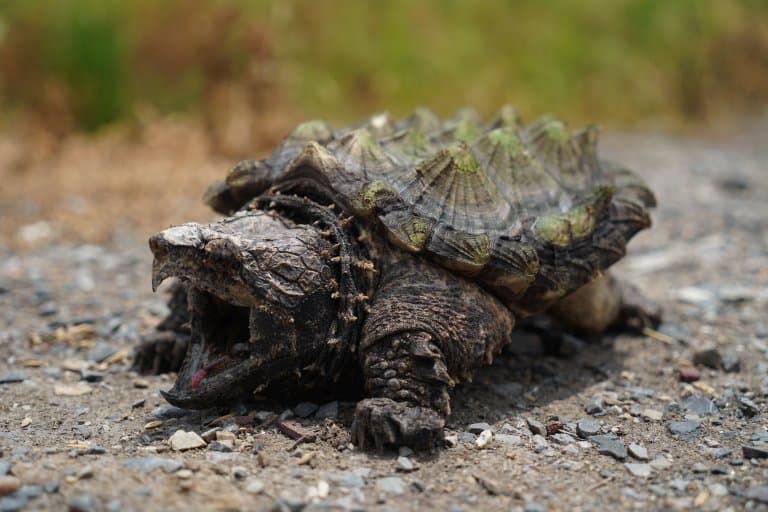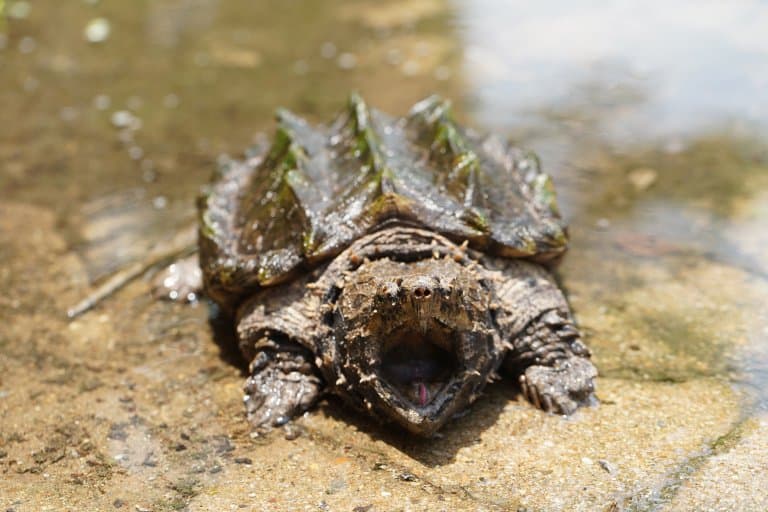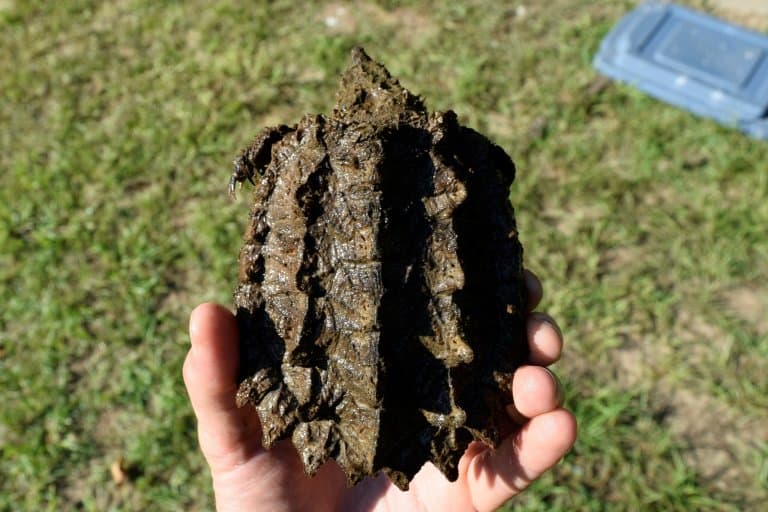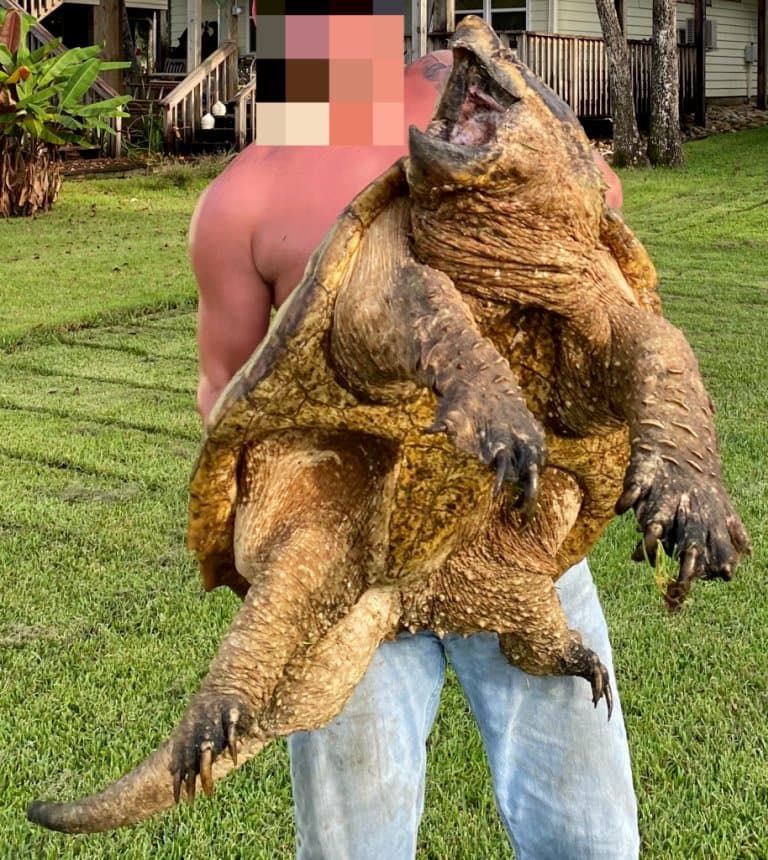Alligator Snapping Turtle Profile
In the swamps of Florida, alligators are well known for their tremendous bite force and ability to lurk undetected in algae-infested waters. But there are other threats, too.
The largest freshwater turtle in North America has a bite force to match and hides just as effectively as its namesake.
The alligator snapping turtle is a large species of turtle that’s native to the USA, and one of the heaviest turtles in the world.

Alligator Snapping Turtle Facts Overview
| Habitat: | Deep fresh waters: rivers, canals, lakes, swamps |
| Location: | Southeast USA, and South Africa |
| Lifespan: | Recorded up to 45 in the wild, 70 in captivity |
| Size: | Up to 81 cm (32 inches) |
| Weight: | Generally up to 90 kg, reports of much heavier |
| Color: | Swampy colors – brown, grey, black and green |
| Diet: | Anything that will fit in its mouth |
| Predators: | Humans, birds, racoons, skunks, alligators |
| Top Speed: | Slow |
| No. of Species: |
1 |
| Conservation Status: |
Vulnerable |
Alligator snapping turtles are generally found in waters that flow into the Gulf of Mexico, preferring areas with tree and shrub cover. They rarely venture onto land, unless a female is nesting. They are solitary creatures, and there is very little social structure or parental care.
Males are typically larger than females, growing up to 81 cm (32 inches) in size and average 70 to 90 kg (155 and 200 lbs) in weight. However, there are reports of much larger specimens, with one particularly large turtle at the Shedd Aquarium in Chicago verified at 113 kg (249 lb) in weight.
The alligator snapping turtle is a generalist predator that lures unsuspecting morsels towards its tremendous jaws. A serrated, bony hooked beak stands at the ready to bifurcate its unlucky prey, and only its tiny nostrils are visible above the swampy water.
They diet on a variety of animals including fish, amphibians, mollusks, snakes, snails, worms, water birds, small rodents that had come to the water to drink, and other turtles.
They’re well adapted to swampy water life, able to pick up on odours while underwater and unearth hidden delicacies. These turtles will make short work of a baby alligator, along with basically anything that wiggles past its face – even if that’s your finger.
Interesting Alligator Snapping Turtle Facts
1. They are named after their ridges on their shell
The three distinct rough dorsal ridges on their shell give it a primitive almost dinosaur appearance, and look like the back of an alligator.
With powerful jaws and a large head, they are unique among snapping turtles for having eyes on the side of the head. It’s powerful jaws and tail are a further similarity to alligators!
The alligator snapping turtle is also sometimes referred to as the ‘loggerhead snapper’.

2. They were confused as a single species
Until recently, the alligator snapping turtle was actually three species of similar animal. Nobody knew this, however, so it’s not their fault.
In 2014, populations of alligator snapping turtles underwent molecular analysis and researchers noticed they were formed of three distinct species.
This would mean that there are now three species of alligator snapper, but the other two got their own names: the Suwannee snapping turtle and Apalachicola snapping turtle, though this last one is still under scrutiny.
Regardless, there remains only one true alligator snapping turtle, despite imitators. 1
3. Hot chicks, cool dudes
Life has been around for a mind-bogglingly long time. We sometimes think of it as being rather straightforward, but the four billion or so years that it’s existed have given it plenty of time to come up with some astonishing survival strategies.
Turtles, along with most crocs and alligators, determine their sex during development and based on the temperature of the eggs. Female turtles are formed between 29 and 30 degrees Celcius, and males at around 25 to 27 degrees.
In the zone in between, there’s a mix of both.
As conditions for their survival change with the temperature, it’s likely that creating more breeding females to compensate is a clever survival strategy, in which a female bias arises.
The adaptive significance of this quirk is still a focus of study, but there is evidence that males in the intermediate temperatures are the most reproductively successful and females are more reproductive in the extreme temperature range.
This is clearly a climate-related survival adaptation and allows populations to control their sex ratios to suit their surrounding environmental conditions, but the full benefit of this has yet to be discovered.
If there was a Nobel prize in zoology, finding the key to this phenomenon might be a contender; it’s definitely a good PhD. Reptiles like this are hard to study on account of their slow breeding cycles. Alligator snappers only breed once a year at best – sometimes once every two or so. 2

4. They use their tongue to draw in prey
These huge turtles move very little. While they do scavenge and hunt, they’re fantastic ambush predators, and they spend most of their time motionless, waiting for prey to come to them.
As a snapper, it has tremendous bite force, which it applies to anything small and unlucky enough to pass by its open jaws.
To make things worse, inside these jaws is a little pink tongue, temptingly wiggling like a fresh worm. This draws the attention of fish, which are subsequently sliced in half and swallowed.
They’re so far the only known turtle to have a lure like this.
5. They smell with their throats
Snapping turtles have chemosensory organs in their necks, which they use to sniff out good scavenge.
Since they live in murky water, their eyes aren’t a lot of use, and instead, they draw water into their throat in a process known as gula pumping to take smell samples of the surrounding water.
Some of the turtle’s chosen prey items like to hide under the muddy sediment, but with this weird gulp-smelling strategy, the snapper can locate them. 3
6. They need to come up for breath every hour
Of all the turtle species, alligator snappers aren’t that great at holding their breath. While some sea turtles are said to stay under for well over an hour (some reports of up to 20h in Loggerheads), alligator snappers have to come up at least every 40-50 minutes, especially in warmer water.
Still, these cold-blooded animals rely on the warmth of their environment to remain snappy. Their lightning-fast jaws can only function at top speed when the water is at the right temperature; too cold and they slow down!
When coming up for air, they rise to the surface but stay entirely submerged other than the protruding nostrils on the end of the snout. 4
7. They’re grumpy
You don’t have to be a prey item to feel the wrath of an alligator snapper. They’re notoriously aggressive both toward other turtle species and even their own.
They generally don’t extend this attitude toward large animals like people unless they’re handled, in which case they might have a snap.
There have been confirmed cases where such a turtle has lopped off a finger or two, which they are more than powerful enough to accomplish.

8. Despite all these handicaps, they still mate underwater
The whole process of mating must be tricky with such an ugly and miserable animal, but it lasts anywhere between 5 and 25 minutes, while submerged in the muddy water.
The female can then remain fertile for up to three years, laying eggs inside nests dug into the dry land. There can be 30 of these eggs in a single nest, and they can lie dormant over winter if necessary.
Before hatching, they’re vulnerable to predators, such as skunks and raccoons.
9. Then, they grow slowly
It can take over twenty years for a hatchling to reach sexual maturity, and this is what makes them so vulnerable to population declines.
They’re commonly hunted by people for meat, but they also suffer from habitat destruction, and with slow reproductive cycles and a really long maturity period, they’re now listed as vulnerable by the IUCN.
Researchers can determine sexual maturity by the size of the turtle’s head: males are sexually mature when their skulls reach around 115 mm. 5

10. They are an invasive species
There are invasive populations of the alligator snapping turtle in South Africa and some have been released or escaped into waters in Czech Republic, Germany and Hungary.
Some countries in the EU have laws against keeping alligator snapping turtles as they are an invasive species that could impact local wildlife populations and delicate ecosystems.
11. There’s never been a fatal attack on a human
Despite their reputation for happily biting off fingers of an unsuspecting human that venture to close, and being suspected by a Bavarian village of Irsee for severing a young boy’s Achilles tendon at a local lake – there’s been no verified cases of human death by the alligator snapping turtle.
It’s a myth that are attack people, unless provoked. However, they can grow large and they have a bite force of 500 pounds, so shouldn’t be picked up! 6

Alligator Snapping Turtle Fact-File Summary
Scientific Classification
| Kingdom: | Animalia |
| Phylum: | Chordata |
| Class: | Reptilia |
| Order: | Testudines |
| Family: | Chelydridae |
| Genus: | Macrochelys |
| Species Name: |
Macrochelys Temmincki |
Fact Sources & References
- THOMAS, T. M., GRANATOSKY, M. C., BOURQUE, J. R., KRYSKO, K. L., MOLER, P. E., GAMBLE, T., ROMAN, J. (2014), “Taxonomic assessment of Alligator Snapping Turtles (Chelydridae: Macrochelys), with the description of two new species from the southeastern United States“, Zootaxa.
- Karla Moeller (2013), “The Adaptive Significance of Temperature-Dependent Sex Determination in a Reptile“, The Embryo Project Encyclopedia.
- Fred Punzo and Lisa Alton (2002), “EVIDENCE FOR THE USE OF CHEMOSENSORY CUES BY THE ALLIGATOR SNAPPING
TURTLE, MACROCLEMYS TEMMINCKII, TO DETECT THE PRESENCE OF MUSK AND MUD TURTLES”, Florida Academy of Sciences, Inc. - “Alligator Snapping Turtle“, Missouri Department of Conservation.
- Brad M. Glorioso (2020), “Alligator Snapping Turtle“, Journal of Fish and Wildlife Management.
- Björn Hengst (2013), “Bavarian Search for Vicious Turtle Continues”, Spiegel.
